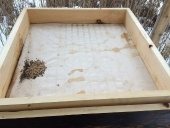Here's an updated link, since that old one is broken:
http://www.anchoragepress.com/news/snow-queens-breeding-bees-survive-alaska-winter
anybody know how far north feral colonies have survived?
I grew up on the Yukon River about 120 miles south of the Arctic Circle. Interior climate, hard by the border with Canada. Definitely no feral honeybees, although we had plenty of native pollinators including bumblebees.
Interestingly in the late 1970s we did have one local beekeeper, a man named Dick Cook, who raised his bees at Sheep Creek on the Tatonduk River about ten miles from the Yukon. (This is hundreds of miles north of Anchorage, where the beekeeper referenced in the article is.) He was what you might call semi-successful at keeping his bees through the winter. I say "semi" because he had a lot more failures than successes. His big problem was that predators (especially bears) would eat his hives when he wasn't present to defend them. I'm not sure if he ever got the same hive through two successive winters, but I believe he wintered them successfully in more than one year. (This is in a place where winter temperatures can drop below 70 below, and routinely drop below fifty below, or did back then anyway.)







